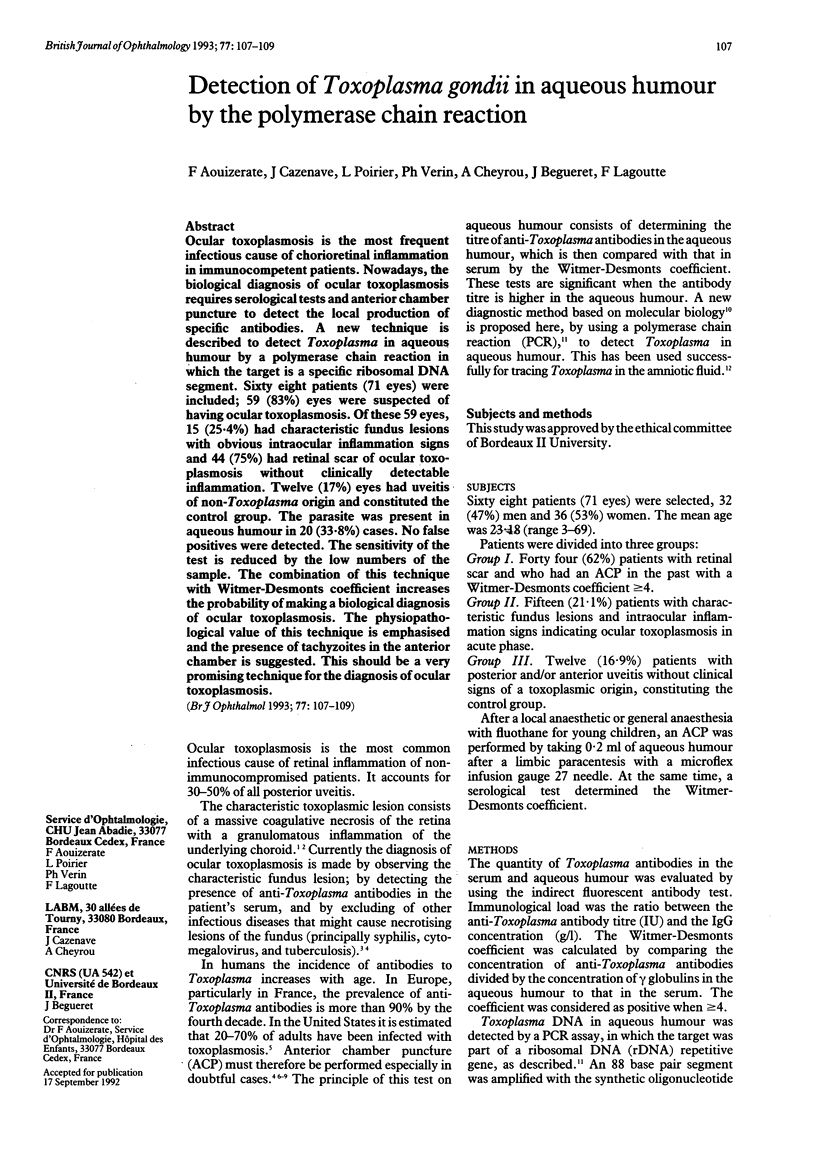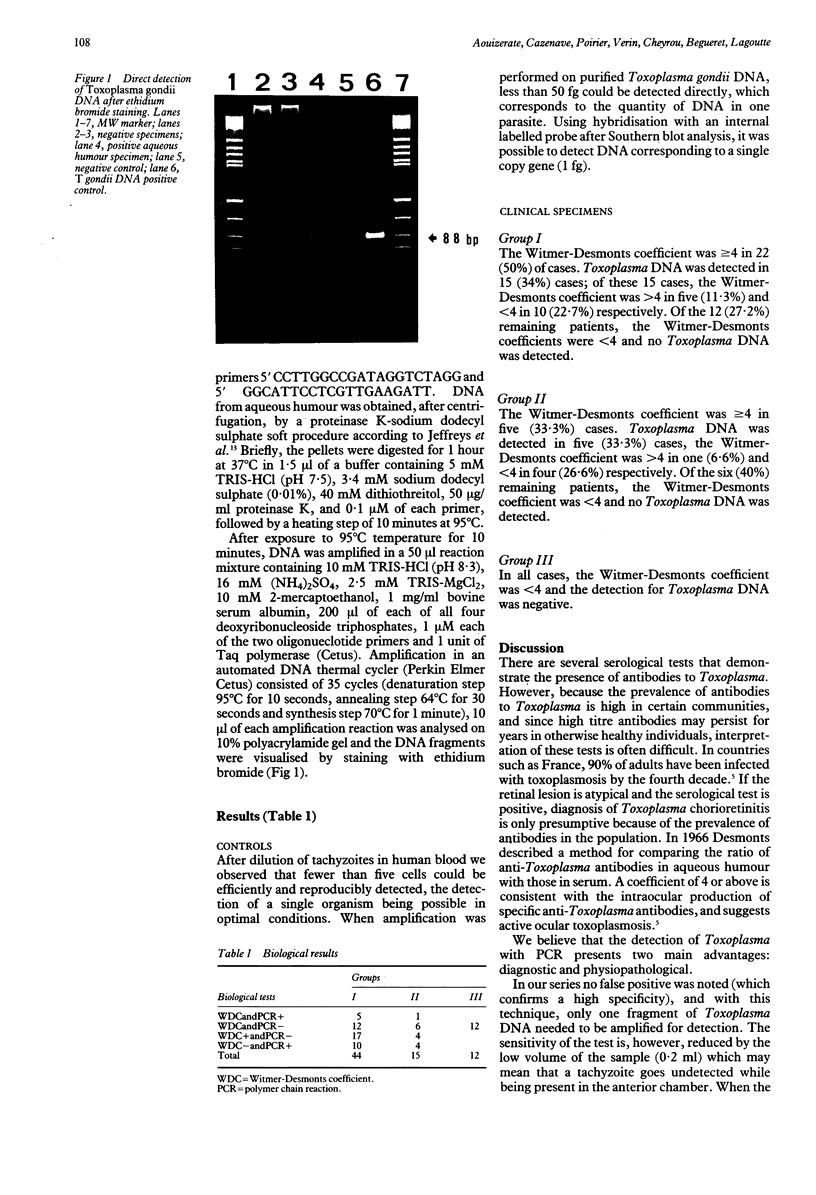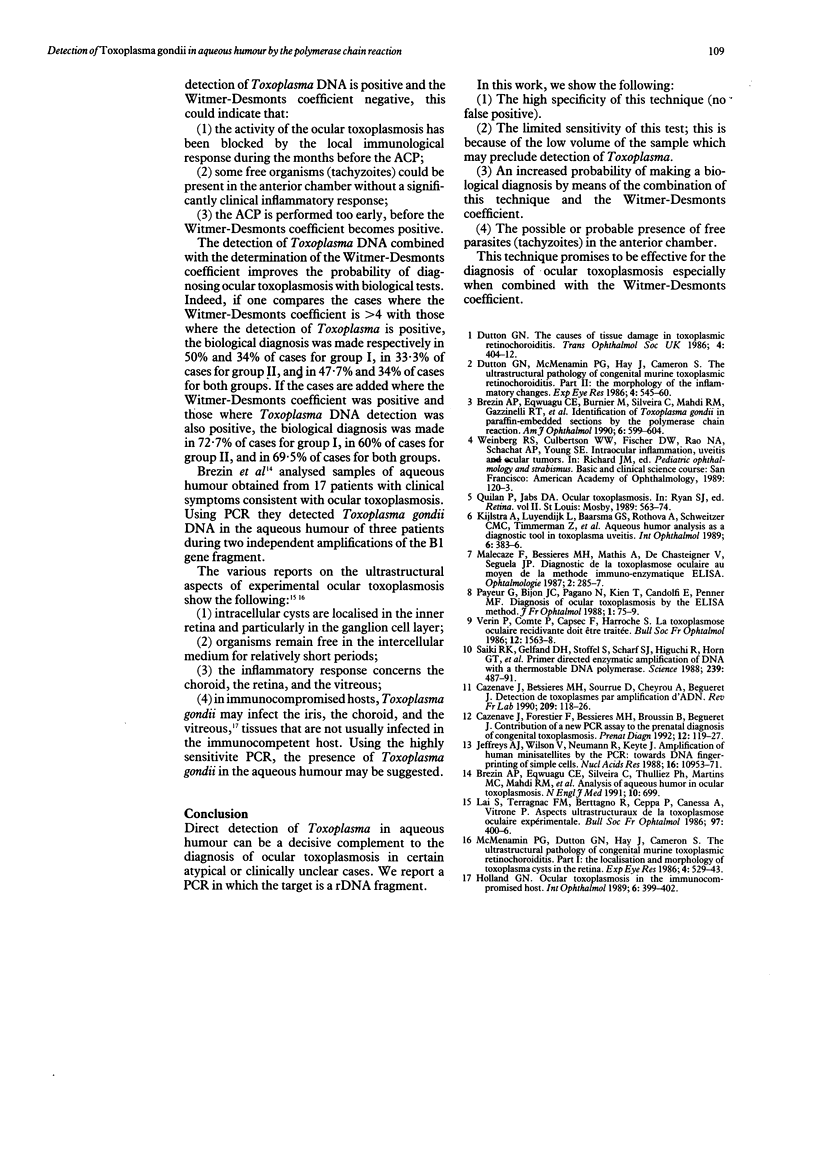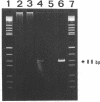Abstract
Ocular toxoplasmosis is the most frequent infectious cause of chorioretinal inflammation in immunocompetent patients. Nowadays, the biological diagnosis of ocular toxoplasmosis requires serological tests and anterior chamber puncture to detect the local production of specific antibodies. A new technique is described to detect Toxoplasma in aqueous humour by a polymerase chain reaction in which the target is a specific ribosomal DNA segment. Sixty eight patients (71 eyes) were included; 59 (83%) eyes were suspected of having ocular toxoplasmosis. Of these 59 eyes, 15 (25.4%) had characteristic fundus lesions with obvious intraocular inflammation signs and 44 (75%) had retinal scar of ocular toxoplasmosis without clinically detectable inflammation. Twelve (17%) eyes had uveitis of non-Toxoplasma origin and constituted the control group. The parasite was present in aqueous humour in 20 (33.8%) cases. No false positives were detected. The sensitivity of the test is reduced by the low numbers of the sample. The combination of this technique with Witmer-Desmonts coefficient increases the probability of making a biological diagnosis of ocular toxoplasmosis. The physiopathological value of this technique is emphasised and the presence of tachyzoites in the anterior chamber is suggested. This should be a very promising technique for the diagnosis of ocular toxoplasmosis.
Full text
PDF


Images in this article
Selected References
These references are in PubMed. This may not be the complete list of references from this article.
- Brézin A. P., Egwuagu C. E., Burnier M., Jr, Silveira C., Mahdi R. M., Gazzinelli R. T., Belfort R., Jr, Nussenblatt R. B. Identification of Toxoplasma gondii in paraffin-embedded sections by the polymerase chain reaction. Am J Ophthalmol. 1990 Dec 15;110(6):599–604. doi: 10.1016/s0002-9394(14)77055-2. [DOI] [PubMed] [Google Scholar]
- Brézin A. P., Eqwuagu C. E., Silveira C., Thulliez P., Martins M. C., Mahdi R. M., Belfort R., Jr, Nussenblatt R. B. Analysis of aqueous humor in ocular toxoplasmosis. N Engl J Med. 1991 Mar 7;324(10):699–699. [PubMed] [Google Scholar]
- Cazenave J., Forestier F., Bessieres M. H., Broussin B., Begueret J. Contribution of a new PCR assay to the prenatal diagnosis of congenital toxoplasmosis. Prenat Diagn. 1992 Feb;12(2):119–127. doi: 10.1002/pd.1970120207. [DOI] [PubMed] [Google Scholar]
- Dutton G. N., McMenamin P. G., Hay J., Cameron S. The ultrastructural pathology of congenital murine toxoplasmic retinochoroiditis. Part II: The morphology of the inflammatory changes. Exp Eye Res. 1986 Oct;43(4):545–560. doi: 10.1016/s0014-4835(86)80022-7. [DOI] [PubMed] [Google Scholar]
- Dutton G. N. The causes of tissue damage in toxoplasmic retinochoroiditis. Trans Ophthalmol Soc U K. 1986;105(Pt 4):404–412. [PubMed] [Google Scholar]
- Holland G. N. Ocular toxoplasmosis in the immunocompromised host. Int Ophthalmol. 1989 Dec;13(6):399–402. doi: 10.1007/BF02306488. [DOI] [PubMed] [Google Scholar]
- Jeffreys A. J., Wilson V., Neumann R., Keyte J. Amplification of human minisatellites by the polymerase chain reaction: towards DNA fingerprinting of single cells. Nucleic Acids Res. 1988 Dec 9;16(23):10953–10971. doi: 10.1093/nar/16.23.10953. [DOI] [PMC free article] [PubMed] [Google Scholar]
- Kijlstra A., Luyendijk L., Baarsma G. S., Rothova A., Schweitzer C. M., Timmerman Z., de Vries J., Breebaart A. C. Aqueous humor analysis as a diagnostic tool in toxoplasma uveitis. Int Ophthalmol. 1989 Dec;13(6):383–386. doi: 10.1007/BF02306485. [DOI] [PubMed] [Google Scholar]
- Malecaze F., Bessières M. H., Mathis A., De Chasteigner V., Seguela J. P. Diagnostic de la toxoplasmose oculaire au moyen de la méthode immuno-enzymatique ELISA. Ophtalmologie. 1987 Apr-Jun;1(2):285–287. [PubMed] [Google Scholar]
- McMenamin P. G., Dutton G. N., Hay J., Cameron S. The ultrastructural pathology of congenital murine toxoplasmic retinochoroiditis. Part I: The localization and morphology of Toxoplasma cysts in the retina. Exp Eye Res. 1986 Oct;43(4):529–543. doi: 10.1016/s0014-4835(86)80021-5. [DOI] [PubMed] [Google Scholar]
- Payeur G., Bijon J. C., Pagano N., Kien T., Candolfi E., Penner M. F. Diagnostic de la toxoplasmose occulaire par la méthode ELISA appliquée au dosage des immunoglobulines de l'humeur aqueuse. J Fr Ophtalmol. 1988;11(1):75–79. [PubMed] [Google Scholar]
- Saiki R. K., Gelfand D. H., Stoffel S., Scharf S. J., Higuchi R., Horn G. T., Mullis K. B., Erlich H. A. Primer-directed enzymatic amplification of DNA with a thermostable DNA polymerase. Science. 1988 Jan 29;239(4839):487–491. doi: 10.1126/science.2448875. [DOI] [PubMed] [Google Scholar]



